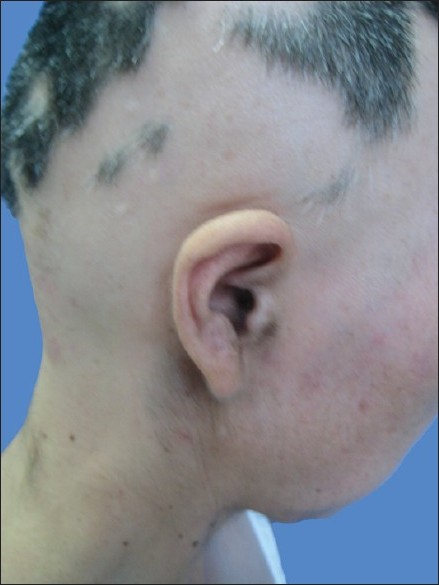Translate this page into:
Coexistence of acquired hypertrichosis and scalp alopecia in a patient with infiltrating ductal carcinoma
2 Department of Dermatology, Hospital of Nanjing Medical University, Nanjing 210029, China
3 Department of Pathology, Hospital of Bengbu Medical College, Anhui 233004, China
Correspondence Address:
Wen-Yuan Zhu
Department of Dermatology, Hospital of Nanjing Medical University, Nanjing 210029
China
| How to cite this article: Zhang RZ, Zhu WY, Zhou L. Coexistence of acquired hypertrichosis and scalp alopecia in a patient with infiltrating ductal carcinoma. Indian J Dermatol Venereol Leprol 2012;78:122 |
Sir,
Hypertrichosis is hair growth that is abnormal for the age, sex, or race of an individual, or for a particular area of the body. It is not only cosmetically disturbing, but the marker of an underlying disease also. [1] Alopecia areata (AA) is postulated to be an organ-specific autoimmune disease with genetic predisposition and an environmental trigger. Although hypertrichosis and scalp alopecia are common signs, coexistence of acquired hypertrichosis and scalp alopecia in the same patient with infiltrating ductal carcinoma is infrequent. Here, we describe this rare condition.
A 55-year-old woman visited our department for evaluation of asymptomatic alopecic areas since one year ago and progressive hypertrichosis over her entire body for 3 months. Two years ago, she was diagnosed with infiltrating ductal carcinoma of the right breast, T2N0M0, stage IIa, and received a modified radical mastectomy with total axillary lymph node dissection and six cycles of chemotherapy, which consisted of pemetrexed injection, cisplatin, capecitabine, and goserelin.
One year ago, the scalp alopecia developed without obvious causative factors; she had not sought medical advice about it. During the past three months, the patient observed many pigmented long and fine hairs occurring on her face, shoulders, and outer aspects of the arms and legs, and was increasing.
Physical examination revealed an apparently healthy woman with multiple, fine, long, pigmented hairs distributed diffusely on the forehead, nuchal region, shoulders, back, abdomen, and lateral aspects of the limbs. Bushy eyebrows and trichomegaly were also observed [Figure - 1]. The axillary and pubic hair appeared normal and there was no evidence of virilization. The scalp hair loss pattern was present as a combination of ophiasis and patches [Figure - 2]. The affected skin appears normal with no epidermal alteration grossly visible, such as scaling or follicular abnormalities. A punch biopsy at the outer edge of the lesion was performed, which did showed the pathological features of metastatic carcinoma compatible with primary tumor of the breast, but clinically indicated common AA.
 |
| Figure 1: Facial hypertrichosis (the hollowed arrows indicate the areas of hypertrichosis), bushy eyebrows, and trichomegaly |
 |
| Figure 2: Scalp alopecia with smooth non-inflamed scalp and intact follicular openings |
Comprehensive screening to rule out an underlying metastasis was undertaken. No suspected local recurrence or metastatic lesion was demonstrated, although CA153 level was significantly higher than the normal value. Without any treatments for AA and hypertrichosis, at a follow-up appointment 4 months later, regrowth of hairs on the alopecic area was seen, but hypertrichosis over the trunk and extremities almost remained unchanged.
Discussion
The mechanisms of hypertrichosis mainly involve two aspects: conversion of vellus to terminal hairs and changes of hair-growth cycle. [2] Another less well-established mechanism of hypertrichosis is an increase in hair follicle density. Systemic diseases, central nervous system diseases, and some drugs could cause hypertrichosis. [3] In our patient, no history of treatment with any drugs related with hypertrichosis, none of the systemic and central nervous system diseases were diagnosed, except for infiltrating ductal carcinoma. It is worth noting that the hair excess presenting as vellus-type hypertrichosis, implying the conversion of vellus to terminal hairs, other than as lanugo type-acquired hypertrichosis, which frequently appears in those patients with malignant tumors. Therefore, we propose that the generalized hypertrichosis over the patient was caused by an as yet unidentified tumor-derived humoral factor may lead to a prolongation of the anagen phase of vellus hair follicles, resulting in hypertrichosis. [4]
If the patient has only hypertrichosis, the value of this report maybe pretty. It is intriguing and puzzling that acquired hypertrichosis and scalp alopecia coexisted in the same patient. To our knowledge, scalp hair loss occurring to a patient with malignant tumor is a frequent side effect of chemotherapy. Doxorubicin containing regimens produce near or total alopecia in most patients. The cyclophosphamide, methotrexate, and fluorouracil regimen was not associated with total hair loss but rather with generalized thinning. However, the scalp hair loss pattern in our patient presented as a combination of ophiasis and patches.
Considering that a rare sequelae of previously diagnosed breast carcinoma metastatic to the scalp is alopecia neoplastica (AN), breast cancer is the primary malignancy in 84% of patients with AN. [5] The punch biopsy of the scalp alopecia was performed, and the AN was ruled out. Four months after initial presentation, we noted that the hairs regrew on the scalp, although the regrowth hairs were not enough to cover the alopecic regions, and hypertrichosis remained unchanged. This observation suggests that some unknown factors impacting the hair growth in AA are eliminated or decreased, but the factors resulting in hypertrichosis were retained. We believe our observation will provide information for understanding of the pathogenetic mechanisms of the abnormal hair growth or loss and the possible relationship to internal malignant neoplasms.
| 1. |
Wendelin D, Pope D, Mallory S. Hypertrichosis. J Am Acad Dermatol 2003;48:161-79.
[Google Scholar]
|
| 2. |
Stenn KS, Paus R. Controls of hair follicle cycling. Physiol Rev 2001;81:449-94.
[Google Scholar]
|
| 3. |
Trüeb RM. Causes and management of hypertrichosis. Am J Clin Dermatol 2002;3:617-27.
[Google Scholar]
|
| 4. |
Uno H, Kurata S. Chemical agents and peptides affect hair growth. J Invest Dermatol 1993;101:143-7S.
[Google Scholar]
|
| 5. |
Conner KB, Cohen PR. Cutaneous metastasis of breast carcinoma presenting as alopecia neoplastica. South Med J 2009;102:385-9.
[Google Scholar]
|
Fulltext Views
1,573
PDF downloads
1,760





